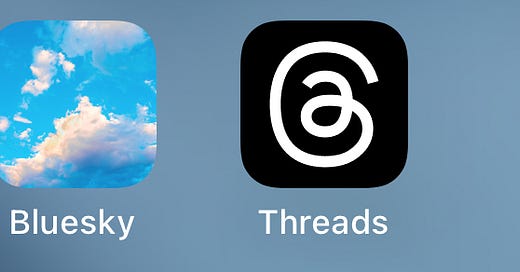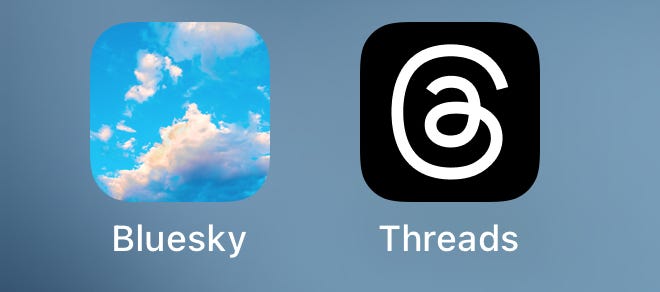The chicken, the egg, and sports social media
A look at some of the reasons why sports media still lives on Twitter
How do you start your digital day?
When you roll over and pick up your phone first thing in the morning, what do you do first?
Nine years ago, I began a chapter of my dissertation with this idea1:
For sports journalists in 2014, there is a new element to the start to their work routine, a relatively new place they go to start their day.
“Twitter is honestly, that’s the first thing I do in the morning,” said Kristin, the sports editor of a metro daily. “I check Twitter to see what’s going on.”
Roger, a college basketball beat writer, said, “Lately, I’ve sort of gotten in the habit of wake up and check (Twitter) to see what things happened overnight.”
After landing on a cross-country flight, Stanley said, “the first thing you do in 2014 is what? You don’t check your email, you check your Twitter account to see what you were missing in the time you were in the air and there’s no WiFi on the plane.”
Right now, at the end of October 2023, is Twitter2 still the place you start your day?
If you’re like me, it’s not.
It’s been almost exactly one year since Elon Musk bought Twitter, and it has been a … um .. interesting year in this area, hasn’t it?
In the previous decade, social media had, for the most part, coalesced around four main platforms. How we used Facebook, Instagram, Twitter, and TikTok/Snapchat for, had become pretty set. Twitter was, for better and for worse, the place for news.
That’s changed in the past year. The space formally controlled by Twitter has now trifurcated into a mess featuring what’s left of Twitter, Bluesky and Threads.
There are excellent cases to be made to leave Twitter for good, both for moral reasons and practical ones. The platform just isn’t as useful as it was, and now is becoming actively dangerous. My good friend Jeremy Littau wrote last week that the current Middle East crisis is the new Twitter’s first test, and it’s failing.
But at the same time, no other social platform has taken its place in the news ecosystem. Ryan Broderick wrote:
Instead of X dissolving into a digital backwater for divorced guys with NFT debt, it has, instead, continued to remain at the top of the digital funnel while also being 4chan-levels of rotten. It is still being used to process current events in “real time” even though it does not have the tools, nor the leadership necessary to handle that responsibility. The inmates are running the asylum and there is nothing on the horizon to convince that that will get better.
What got me thinking about all this was looking at Bluesky and Threads, and realizing what I don’t see there.
Sports.
Sports news.
Sports discussion.
Sports sports sports.
There’s some, but not at the level of the old joint. Despite all of the good reasons for journalists, news organizations, and people to leave Twitter, sports journalists and sports are still there.
And I’m wondering why?
If there are so many good reasons to quit Twitter, why does sports media still live there?
The obvious answer3 is “that’s where the audience is.” I polled people who follow me on the Twitter, Bluesky, and Threads, and the overwhelming answer4 I got is that for its many faults, Twitter is still where sports talk happens.
It’s a modern media chicken-egg situation. There's not much sports chatter on Blue Sky or Threads because there aren't sports people there. But there aren't any sports people there because there's no sports chatter there.
And so it goes.
If you want to follow Victor Wembayana’s debut, or complain about the Buffalo Bills5, doing so on Bluesky or Threads still feels a bit like shouting into a void. Twitter, at least that void is answered, even if it’s mainly by idealgues willing to pay $8 a month.
This makes sense from an audience perspective. One theory that helps us understand audience behavior in this area is uses and gratifications.
Uses and gratifications is a theory developed by media psychologists in the 1970s as a way to explain media effects on audience members. As defined by Alan Rubin, “audience members take the initiative in selecting these media and are not simply passive targets of media messages.”
Rubin late writers:
“Uses and gratifications emphasizes individual choice. People choose among available communication or functional alternatives. They make their choices based on their wants, interests, and expectations.”
If you’re reading that and thinking something like, “well, duh!” you’re not wrong. Historical context matters here. For a good part of the 20th century, the media effects space was dominated by theories built around the idea of a passive audience, one that was to some extent controlled by mass media. This is how underpinning the famous (if widely misunderstood) War of the Worlds broadcast.
Uses and Gratifications turns that around and says that the audience has way more agency that previously thought. The audience is not a monolith. It is made up of individuals who consume a given piece of media because it fulfills a specific need they have, either a pragmatic purpose (use) or a want (gratification).
This can help us understand why sports fans stay on Twitter despite everything going on. Twitter still fills the need that the other platforms do not yet.
The audience factor also explains why sports journalists remain active on Twitter. Writing and reporting exists to be seen, and so of course media members are going to go where their audience is — even if it is a platform run by and populated by people who consider the free press the enemy of the people.
But it’s not just the audience. It’s the routine.
From my 2014 dissertation:
In many ways, sports journalism starts on Twitter.
When news breaks on her college football beat, Kayla described her reporting process like this: “First of all, you go on Twitter, because that’s generally where news breaks nowadays.”
Whether it’s used for finding ideas for stories or reporting the news, Twitter has become tightly integrated into how sports journalists do their job. Reporters either learn about news on their beat from Twitter (through other media outlets or the team and players themselves) or break stories on Twitter after doing their own offline reporting. The interviews suggest that this holds true across beats, across news organizations, and across differences in a reporter’s gender and experience.
What’s interesting is that when I wrote this 10 years ago, this was a profound change in reporter’s routines. There was still a hint of an attitude that by posting breaking news on Twitter, newspapers were giving away content and stories that should go on their home page.
But reporting news on Twitter has become not only the start point for sports journalism, but a central part of the job.
Routines are hard to break. They exist because they either actively serve or have served a real purpose. You can call it a use and gratification, you can call it aligning with incentives, you can call it force of habit. If the routine serves you personally and professionally, it’s not a bad thing. There’s comfort in routine.
There’s also this:
Reporters have more autonomy in their work online, particularly on Twitter, than they do in their work for print. The autonomy means they are making decisions about what news to publish, when to publish it, and to what platform
I hadn’t thought of this in a long time, but this could be a sneaky reason why Twitter was so popular with journalists, even though the audience was so relatively small compared to other social platforms. The autonomy. The ability to use even that small bit of space in a Tweet to write what you want, without it having to be approved by an editor. That freedom to write what you think, to post about Springsteen, to clap back at a reader.
In an era when your job definition is changing and your entire industry seems to be falling apart, you take whatever autonomy you can get. And Twitter provided a small measure of that autonomy, 140 to 280 characters at a time.
And so it makes sense that after a decade or more of posting to Twitter, of hearing from people like me that they need to be active on Twitter, of building an audience on Twitter, and getting comfortable with platform’s own norms and practices, that journalists would be hesitant to move on to a new platform that kind of looks the same but isn’t quite the same.
Without a compelling reason or organizational support to change, there’s nothing to be gained by switching.
But given the state of the old joint, is there anything to be gained by staying?
The names are pseudonyms.
Never calling it X. Just because Dollar General Tony Stark thinks that letter is cool doesn’t mean I have to abide by his naming conventions.
My friend and frequent co-author Michael Mirer correctly pointed out that Bluesky is a closed, invite-only platform. This is a feature, not a bug, but it does probably explain a lot of this. Also, if you want a code to Bluesky, I know a guy. It’s me. I’m the guy.
As an interesting data point, I got the most responses on Bluesky. Followed by Threads. Twitter, I might as well have posted on Google+.
The offense is stagnant. The coaches seemingly forgot they have a human bison at quarterback. The defense has lost all its playmakers to injury and got carved up like a rotisserie chicken by Mac Jones. Hey-ey-ey-ey …



